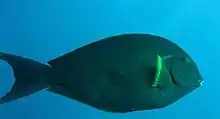| Acanthurus albipectoralis | |
|---|---|
 | |
| Scientific classification | |
| Domain: | Eukaryota |
| Kingdom: | Animalia |
| Phylum: | Chordata |
| Class: | Actinopterygii |
| Order: | Acanthuriformes |
| Family: | Acanthuridae |
| Genus: | Acanthurus |
| Species: | A. albipectoralis |
| Binomial name | |
| Acanthurus albipectoralis G. R. Allen & Ayling, 1987 | |
.JPG.webp)
Acanthurus albipectoralis, the whitefin surgeonfish, is a species of marine ray-finned fish belonging to the family Acanthuridae, the surgeonfishes, unicornfishes and tangs. This species is found in the Western Pacific Ocean.
Taxonomy
Acanthurus albipectoralis Was first formally described in 1987 by Gerald R. Allen and Anthony Michael Ayling with its type locality given as Swain Reef in the Great Barrier Reef off Queensland.[2] The genus Acanthurus is one of two genera in the tribe Acanthurini which is one of three tribes in the subfamily Acanthurinae which is one of two subfamilies in the family Acanthuridae.[3]
Etymology
Acanthurus albipectoralish has the specific nae albipectoralis which is a compound of albus, meaning "white", and pectoralis, meaning "pectoral". This is a reference to the white distal partof the pectoral fins contrasring with the overall black colour of this fish.[4]
Description
Acanthurus albipectoralis has an oblong, laterally compressed body with a blunt snout. The dorsal and anal fins are relatively long and low and are supported by 8 or 9 spines and between 22 and 33 soft rays for the dorsal fin and 3 spines and between 18 and 31 soft rays for the anal fin. The caudal fin is crescentic and has pointed tips on each lobe. The overall colour is black without any wavy blue lines. The pectoral fin has a blackish base and a clear white distal portion.[5] This species attains a maximum publisjed standard length of 33 cm (13 in).[6]
Distribution and habitat
Acanthurus albipectoralis is found in the southwestern Pacific Ocean from eastern Autralia to Tonga.[6] They are found on the exposed outer slopes of reefs, typically in small groups high in the water column feeding on zooplankton.[5]
References
- ↑ Russell, B.; Stockwell, B.; Nanola, C.; et al. (2012). "Acanthurus albipectoralis". IUCN Red List of Threatened Species. 2012: e.T178007A1519102. doi:10.2305/IUCN.UK.2012.RLTS.T178007A1519102.en. Retrieved 19 November 2021.
- ↑ Eschmeyer, William N.; Fricke, Ron & van der Laan, Richard (eds.). "Species in the genus Acanthurus". Catalog of Fishes. California Academy of Sciences. Retrieved 2 September 2023.
- ↑ J. S. Nelson; T. C. Grande; M. V. H. Wilson (2016). Fishes of the World (5th ed.). Wiley. pp. 497–502. ISBN 978-1-118-34233-6.
- ↑ Christopher Scharpf & Kenneth J. Lazara, eds. (12 January 2021). "Order ACANTHURIFORMES (part 2): Families EPHIPPIDAE, LEIOGNATHIDAE, SCATOPHAGIDAE, ANTIGONIIDAE, SIGANIDAE, CAPROIDAE, LUVARIDAE, ZANCLIDAE and ACANTHURIDAE". The ETYFish Project Fish Name Etymology Database. Christopher Scharpf and Kenneth J. Lazara. Retrieved 3 September 2023.
- 1 2 Bray, D.J. (2018). "Acanthurus albipectoralis". Fishes of Australia. Museums Victoria. Retrieved 3 September 2023.
- 1 2 Froese, Rainer; Pauly, Daniel (eds.) (2023). "Acanthurus albipectoralis" in FishBase. June 2023 version.
